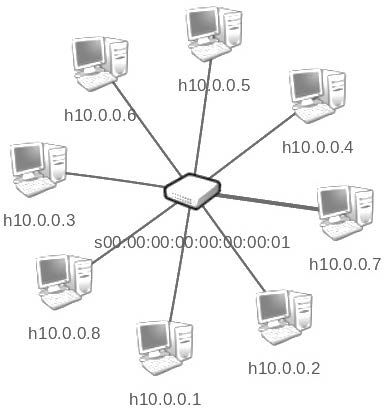On the features of Software Defined Networking for the QoS provision in data networks
DOI:
https://doi.org/10.17981/ingecuc.14.2.2018.10Keywords:
Software Defined Networking, SDN, Floodlight, Mininet, Packet Tracer, quality of service, bandwidth, queuing, transmission rate, response timeAbstract
Introduction: The traditional networks mostly implement devices where the control plane is distributed and mixed with the data plane; this fact does not allow a fast evolution towards a process that contributes to improving the transport of services. Otherwise, Software Defined Networking is a set of transport services that optimize the use of resources as these have a centralized network structure.
Objective: To determine the aspects that enable software-defined networking to provide quality of service features in data networks.
Methodology: This study is performed through network simulation over the same base network and under the same working conditions by carrying out measurements of the packet forwarding response time and management of the transported bandwidth. This study includes the demonstration of the multimedia content transport over a network architecture defining priorities to the links.
Results: The outcomes show how the Software Defined Networking achieves better management of data transmission through the base network. In the same way, the previous outcomes are reinforced with those obtained in the quality of service test performed on the streaming of a multimedia flow.
Conclusions: Due to the centralized control of Software Defined Networking, forwarding functions with the quality of service features are enabled in data networks based on layer-2 devices.
Downloads
References
N. Feamster, J. Rexford and E. Zegura, "The Road to SDN: An Intellectual History of Programmable Networks." ACM Sigcomm Computer Communication, vol. 44, no. 2, pp. 87–98. 2014. http://doi.org/10.1145/2602204.2602219
A. Basit, S. Qaisar, S. H. Rasool, and M. Ali, “SDN Orchestration for Next Generation Inter-Networking: A Multipath Forwarding Approach,” IEEE Access, vol. 5, pp. 13077–13089, 2017. http://doi.org/10.1109/ACCESS.2017.2683943
H . Kim and N. Feamster, “Improving network management with software defined networking,” IEEE Commun.Mag., vol. 51, no. 2, pp. 114–119, 2013. http://doi.org/10.1109/MCOM.2013.6461195
N. McKeown, T. Anderson, H. Balakrishnan, G. Parulkar, L. Peterson, J. Rexford, S. Shenker, and J. Turner, “OpenFlow: Enabling Innovation in Campus Networks” ACM SIGCOMM Comput. Commun. Rev., vol. 38, no. 2, p. 69, 2008. http://doi.org/10.1145/1355734.1355746
F. Laassiri, M. Moughit and N. Idboufker, “Evaluation of the QoS parameters in different SDN architecture using Omnet 4.6++,” 2017 18th International Conference on Sciences and Techniques of Automatic Control and Computer Engineering (STA), Monastir, Tunisia, 2017, pp. 690-695. http://doi.org/10.1109/STA.2017.8314976
M. A. Barry, J. K. Tamgno, C. Lishou and M. B. Cissé, “QoS impact on multimedia traffic load (IPTV, RoIP, VoIP) in best effort mode,” 2018 20th International Conference on Advanced Communication Technology (ICACT), Chuncheon-si Gangwon-do, Korea (South), 2018, pp. 694-700. http://doi.org/10.23919/ICACT.2018.8323886
M. Haiyan, Y. Jinyao, P. Georgopoulos and B. Plattner, “Towards SDN based queuing delay estimation,” in China Communications, vol. 13, no. 3, pp. 27-36, March 2016. http://doi.org/10.1109/CC.2016.7445500
X. Li, J. Yan, and H. Ren, “Software defined traffic engineering for improving Quality of Service,” China Commun., vol. 14, no. 10, pp. 12–25, Oct. 2017. http://doi.org/10.1109/CC.2017.8107629
B. Awerbuch, S. Kutten and D. Peleg, “On buffer-economical store-and-forward deadlock prevention,” IEEE INFCOM ‘91. The conference on Computer Communications. Tenth Annual Joint Comference of the IEEE Computer and Communications Societies Proceedings, Bal Harbour, FL, USA, 1991, pp. 410-414 vol. 1. http://doi.org/10.1109/INFCOM.1991.14753
I. Afolabi, T. Taleb, K. Samdanis, A. Ksentini, and H. Flinck, “Network Slicing and Softwarization: A Survey on Principles, Enabling Technologies, and Solutions,” IEEE Commun. Surv. Tutorials, vol. 20, no. 3, pp. 2429–2453, 2018. http://doi.org/10.1109/COMST.2018.2815638
Y. Yan and H. Wang, “Open vSwitch Vxlan performance acceleration in cloud computing data center,” 2016 5th International Conference on Computer Science and Network Technology (ICCSNT), Changchun, 2016, pp. 567-571. http://doi.org/10.1109/ICCSNT.2016.8070222
Y. Yan and H. Wang, “Open vSwitch Vxlan performance acceleration in cloud computing data center,” 2016 5th International Conference on Computer Science and Network Technology (ICCSNT), Changchun, 2016, pp. 567-571. http://doi.org/10.1109/ICCSNT.2016.8070222
M. Vijayalakshmi, P. Desai and M. M. Raikar, “Packet Tracer Simulation Tool as Pedagogy to Enhance Learning of Computer Network Concepts,” 2016 IEEE 4th International Conference on MOOCs, Innovation and Technology in Education (MITE), Madurai, 2016, pp. 71-76. http://doi.org/10.1109/MITE.2016.024
M. J. Mišić and S. R. Gajin, “Simulation of Software Defined Networks in Mininet environment,” 2014 22nd Telecommunications Forum Telfor (TELFOR), Belgrade, 2014, pp. 1055-1058. http://doi.org/10.1109/TELFOR.2014.7034588

Downloads
Published
How to Cite
Issue
Section
License
Published papers are the exclusive responsibility of their authors and do not necessary reflect the opinions of the editorial committee.
INGE CUC Journal respects the moral rights of its authors, whom must cede the editorial committee the patrimonial rights of the published material. In turn, the authors inform that the current work is unpublished and has not been previously published.
All articles are licensed under a Creative Commons Attribution-NonCommercial-NoDerivatives 4.0 International License.


 English
English
 Español (España)
Español (España)






















